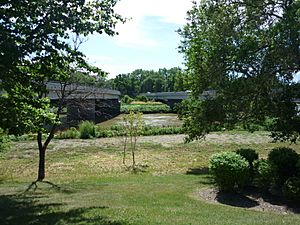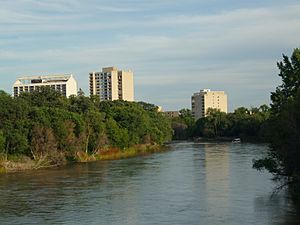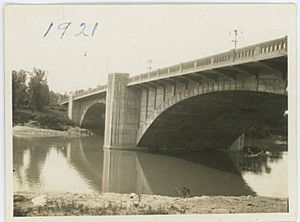Maryland Bridge facts for kids
Quick facts for kids Maryland Bridge |
|
|---|---|
 |
|
| Carries | |
| Crosses | Assiniboine River |
| Locale | Winnipeg, Manitoba |
| Maintained by | City of Winnipeg |
| History | |
| Construction end | 1969 (southbound side) 1970 (northbound side) |
| Statistics | |
| Daily traffic | 25,400 per day (2013) |
The Maryland Bridge is an important bridge in Winnipeg, Manitoba. It crosses over the Assiniboine River. This bridge helps many people travel across the city every day. It connects Academy Road with Maryland Street and Sherbrook Street.
The bridge you see today is actually the third one built in this spot. All three bridges have been called the Maryland Bridge. Close by, you can find places like the Misericordia Health Centre, Cornish Library, and Shaarey Zedek Synagogue.
Contents
Exploring the Maryland Bridge's Past
The First Bridge: 1894 to 1921
The very first Maryland Bridge was built in 1894. People sometimes called it the Boundary Bridge. This was because Maryland Street used to be the western edge of Winnipeg. In 1915, there was an idea to make the bridge a war memorial. However, the bridge was taken down before this plan could happen.
Street car service on the first bridge stopped in June 1920. Around the same time, people worried about the bridge's safety. Heavy vehicles and street cars were not allowed to cross it anymore. The original Maryland Bridge was removed in 1921. This happened after the second bridge was finished.
The Second Bridge: 1921 to 1969
Because of more traffic and safety concerns, a new bridge was needed. Construction on the second Maryland Bridge started in 1920 and finished in 1921. In 1951, a special "Cut-Off" was added. This helped drivers turn off the bridge onto Wellington Crescent more easily. It helped reduce traffic jams.
The second bridge was closed in 1969 when the new "Twin Bridge" opened its first part. A special monument remembers the second bridge. It's called the Maryland Twin Bridge Monument. It has a stone pillar that was saved from the old bridge.
The Current Bridge: 1969 to Today
The bridge we use today opened in two steps. The western side opened on November 8, 1969. The eastern side opened on August 5, 1970. The government of Manitoba helped pay for it. The Metropolitan Corporation of Greater Winnipeg built it. In 2013, the Maryland Bridge was one of Winnipeg's busiest bridges. About 25,400 cars crossed it each day.
The Maryland Bridge was part of the first Manitoba Marathon route in 1979. Today, the marathon route is different and no longer crosses this bridge.
Since 1995, the Maryland Bridge has been a special place for a fundraiser. It's for the Misericordia Health Centre Foundation. Volunteers dress as angels and offer coffee to drivers. They ask for donations to help the health centre. In 2015, the Angel Squad even set a Guinness World Record for the largest group of angels!
The Maryland Bridge has also been used to honor missing and murdered Indigenous women and girls. In the 2010s, red ribbons were tied to bridges across Winnipeg. Each ribbon stood for an Indigenous woman who was missing or had been killed. Some ribbons were removed from the Maryland Bridge by unknown people. But an Indigenous men's support group, Healing Together, found and replaced them in early 2021.
How the Bridge Was Built
Original Bridge Design
The first Maryland Bridge was made of steel. The Winnipeg Free Press newspaper described it as having a "Renaissance character." This means it had classic shapes and details.
Second Bridge Design
The second bridge was made of concrete arches. It had a special look because of red granite pieces mixed into the concrete. Workers scrubbed the concrete with brushes. Then they washed it with acid and water. This made the red granite show through.
Current Bridge Design
The bridge we use now is made of strong concrete structures. It has two separate parts, one for each direction of traffic. These parts are made of special concrete beams called girders. The northbound side of the bridge was updated in 2005. The southbound side was updated in 2006.



